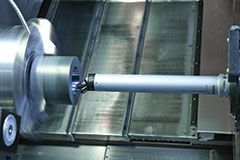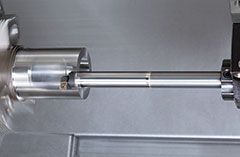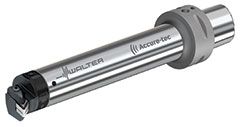by Kip Hanson
Five tooling manufacturers weigh in on ways to stop chatter during internal turning operations
Lower RPM. Higher feedrates. Different depths of cut. A light hone, heavy hone, or no hone at all on the cutting edge. Lead, brass and aluminum sleeves. Boring bar shanks hollowed out and filled with low-melt alloy. Carefully applied pressure with a broomstick. These were the tactics used to stop boring bar chatter when I stood in front of a CNC lathe, tactics that often provided only limited success. And in those all too common instances where we were unable to meet the required surface finish or diametral tolerance, the parts would be sent to a specialty house for gun drilling or honing, driving up production costs and lengthening lead-time. Fortunately for lathe machinists today, there are far more effective options available. Here are five recommendations from the leaders in anti-vibration technology.
Ashok Guruswamy
product manager for Grip/Turn/Thread at Iscar Tools, Canada
“During machining, a vibrating tool generates undulations on a workpiece surface. In the subsequent pass, the tool is then machining an already wavy surface, leaving behind a newly generated wavy pattern. This phenomenon has a cumulative effect that can greatly amplify vibrations and lead to chatter, which in turn causes a rough surface finish, increased cutting forces, reduced tool and machine life, decreased productivity, and irritatingly high noises. Iscar’s Whisperline Anti-Vibration tools are designed for large overhang situations, between 7 x D and up to 14 x D. These tools include a Dynamic Vibration Absorber (DVA) system, a heavy tungsten mass supported by elastomeric components and located in an internal cavity as close to the machining area as possible to increase damping and therefore stability during machining. The reactive damping mechanism comes into action during machining with high overhang work depths and acts as an effective counter to vibrations. The highly effective, anti-vibration damper effect is applicable for large D.O.C and high feed rates, and ensures continuous, efficient machining. These factors enable increased productivity, improvement in surface quality on high overhangs, and enhanced profitability.”
 Munson
Munson
technical sales specialist for Silent Tools at Sandvik Coromant
“One of the biggest challenges with deep boring applications is knowing what’s going on inside the workpiece. Sandvik Coromant has responded to this by equipping its Silent Tools line of damped boring bars with Bluetooth-capable embedded sensors that communicate with a mobile device such as a tablet or smartphone, and in some cases, with the control on the machine tool itself. This provides the operator with real-time data on vibration characteristics, bar deflection, the temperature of the boring head, and so on, giving him or her the information necessary to make better machining decisions. The bar can also be used as a standard Silent Tool. We have different lengths and diameters available, the longest a carbide-reinforced version that goes up to 14 x D. Each uses a heavy metal damper supported by rubber springs and surrounded by oil, and is pre-tuned according to the bar’s length, so are quite easy to use. This is augmented by a quick-change modular head that also supports internal threading and grooving operations. The result is productivity gains of up to 400 per cent on very long overhang applications.”
 Olivier Branget
Olivier Branget
product specialist for Steadyline anti-vibration products at Seco Tools
“A lot of the times we visit a customer that’s trying to use a standard steel or carbide bar, they’re either breaking inserts, scrapping parts, or are simply unable to meet the surface finish requirements. This is why Seco Tools developed the Steadyline modular anti-vibration tooling system, designed for problem-free boring up to 10 x D in rotary and static applications. The damped bar uses our GL interface, a fine-pitch threaded connection that allows the operator to swap out heads quickly and accurately. The system has been out for a couple of years now and has shown great success, so we’re currently in the process of expanding it with more bars and more head options. Steadyline has coolant-through capability and allows the operator to increase feedrates significantly, so it provides better chip control, and with chip control comes improved surface finish, accuracy, and tool life.”
 David Essex
David Essex
turning product manager for Tungaloy America
“Solid carbide boring bars can be used successfully up to about six times the bar diameter. Our BoreMeister tools are designed for applications where the boring bar is projecting out 7 x D and 10 x D. They use an internal weight and spring mechanism to counteract bar movement and cancel out the vibrations that cause poor surface finish or premature insert damage due to chipping. The tools have two components, one being the de-vibe bar itself, the other a screw-on head that’s available in a range of insert geometries. To help the effectiveness of the de-vibe bars, it’s key to keep depths of cut light at 0.25 to 0.63 mm per side (0.010 to 0.025 in.) at moderate surface speed in the range of 400 to 500 sfm, depending on the material. Positive rake chip breakers also help to minimize tool forces and vibrations. All are suitable for general machine shop work, but are especially popular with aerospace shops and oil and gas applications, where long reaches and difficult materials are common.”
 Sarang Garud
Sarang Garud
product manager at Walter USA
“Our new Accure.tec tools have a patented, pre-tuned heavy metal damper that acts in both radial and axial directions. This means the operator can just put the bar on the machine and start machining, no matter if it’s a finishing or roughing operation. Additionally, our QuadFit cutting head interface provides a very short overhang and low weight and is positioned as close as possible to the dampener, which is important for good vibration-damping performance. The Accure.tec can be used in both turning and milling operations, with typical length to diameter ratios of 6 x D up to 10 x D, although deeper applications can also be tackled. The Accure.tec bars also promise a quick and precise head change (± 0.002 mm), and the bars themselves use standard industry connections such as Capto, HSK and cylindrical shanks. All have internal coolant capacity, and the milling bars are available with a shell mill connection.”
Putting the pedal to the metal
The application advice from each of these companies is similar. Avoid clamping the bar with set screws, using a split sleeve instead. Indicate the bar in to assure centreline, or use a commercially available setting device. Apply high pressure coolant through the tool whenever possible to keep the bore free of chips. Maintain feeds and speeds comparable to, and in some cases higher, than those of shallow boring applications, although depending on the material and rigidity of the setup, the depth of cut may have to be reduced slightly. And above all else, don’t wait. Solid carbide and steel bars still have their place, but anti-vibration bars almost always provide better tool life and smoother surface finishes, with minimal hassle. Why use anything else? SMT
